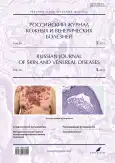Comparative descriptive analysis of socio-demographic status in immunocompetent and immunocompromised patients with mycoses of the skin, hair and nails
- Authors: Ivanova Y.A.1, Klimko N.N.2, Khairutdinov V.R.3, Ponomarenko I.G.3, Telichko I.N.1
-
Affiliations:
- Almazov National Medical Research Centre
- North-Western State Medical University named after I.I. Mechnikov
- Kirov Military Medical Academy
- Issue: Vol 26, No 5 (2023)
- Pages: 497-506
- Section: DERMATOLOGY
- Submitted: 21.06.2023
- Accepted: 08.09.2023
- Published: 17.11.2023
- URL: https://rjsvd.com/1560-9588/article/view/340828
- DOI: https://doi.org/10.17816/dv340828
- ID: 340828
Cite item
Abstract
BACKGROUND: Despite the achievements of modern medicine, people's susceptibility to fungal infections is only increasing. In this regard, it is extremely important to understand which social factors are most characteristic of people suffering from mycoses of the skin, hair and nails.
AIM: to study the socio-demographic status of immunocompetent and immunocompromised patients with mycoses of skin, hair and nails.
MATERIALS AND METHODS: A multicenter prospective cohort observational study of the social and demographic characteristics of immunocompetent and immunocompromised individuals with mycoses of the skin of hair and nails was conducted. Four groups of patients were formed: immunocompetent persons, persons with diabetes mellitus, patients with autoimmune diseases while taking immunosuppressants, patients with infection human immunodeficiency virus (HIV). A total of 646 people were examined. To ensure the quality of research and information processing, questionnaires were developed to be filled in for each examined patient. At the time of inclusion in the study, data concerning the place of residence and living conditions of patients, their lifestyle, marital status, bad habits and profession were entered into the questionnaires.
RESULTS: Significant differences (p <0.0001) were revealed between the studied socio- demographic characteristics in the study groups. The age of immunocompetent patients with mycoses of skin, hair and nails was 9–14 years lower than the age of immunocompromised. Female persons prevailed in the case of autoimmune diseases ― 71.1%. Harmful habits were registered in 60% of patients with superficial mycoses and HIV. 83.33% of autoimmune patients were married. Urban residents prevailed over rural residents in the case of diabetes mellitus and autoimmune pathology. Persons of manual work professions in 48.48% of cases were identified among patients with HIV infection, which was more than in other study groups.
CONCLUSION: When studying the socio- demographic characteristics of patients with mycoses of skin, hair and nails, significant differences were revealed in all the factors studied. The obtained results indicate the need to develop a personalized approach to the diagnosis, prevention and treatment of these infections.
Full Text
About the authors
Yuliya A. Ivanova
Almazov National Medical Research Centre
Author for correspondence.
Email: ivanova.ua@gmail.com
ORCID iD: 0009-0006-8529-458X
SPIN-code: 1773-5430
MD, Cand. Sci. (Med.), Assistant Lecturer
Russian Federation, Saint PetersburgNikolay N. Klimko
North-Western State Medical University named after I.I. Mechnikov
Email: ivanova.ua@gmail.com
MD, Dr. Sci. (Med.), Professor
Russian Federation, Saint PetersburgVladislav R. Khairutdinov
Kirov Military Medical Academy
Email: haric03@list.ru
ORCID iD: 0000-0002-0387-5481
SPIN-code: 4417-9117
MD, Dr. Sci. (Med.), Associate Professor
Russian Federation, Saint PetersburgInga G. Ponomarenko
Kirov Military Medical Academy
Email: manga-85@mail.ru
ORCID iD: 0000-0001-6550-6940
SPIN-code: 7930-2463
MD, Dr. Sci. (Med.), Associate Professor
Russian Federation, Saint PetersburgIgor N. Telichko
Almazov National Medical Research Centre
Email: telichko@kvd4.com
ORCID iD: 0000-0001-7544-654X
SPIN-code: 5426-4374
MD, Dr. Sci. (Med.), Professor
Russian Federation, Saint PetersburgReferences
- Ridzuan PM, Nazira CM, Ruth M, et al. Mini review on dermatomycosis. J Sci Mathemat Lett. 2020;8(1):6–15. doi: 10.37134/jsml.vol8.1.2.2020
- Sokolova TV, Malyarchuk TA. Epidemiology of foot mycoses (Literature review). Epidemiol Vaccinat. 2015;(1):70–74. (In Russ).
- Zahur M, Afroz A, Rashid U, Khaliq S. Dermatomycoses: Challenges and human immune responses. Curr Protein Peptide Sci. 2014;15(5):437–444. doi: 10.2174/1389203715666140512121349
- Nenoff P, Krüger C, Ginter-Hanselmayer G, Tietz HJ. Mycology: An update. Part 1: Dermatomycoses: Causative agents, epidemiology and pathogenesis. J Dtsch Dermatol Ges. 2014;12(3):188–209; quiz 210, 188-211; quiz 212. doi: 10.1111/ddg.12245
- Ivanova YA. Surface mycoses of the population of the Altai Territory identified during active medical preventive examinations. Problems Med Mycol. 2012;14(2):30–33. (In Russ).
- Eckhart L, Zeeuwen PL. The skin barrier: Epidermis vs environment. Exp Dermatol. 2018;27(8):805–806. doi: 10.1111/exd.13731
- Raznatovsky KI, Rodionov AN, Kotrekhova LP. Dermatomycoses. Saint Petersburg; 2006.159 р. (In Russ).
- Powell J, Porter E, Field S, et al. Epidemiology of dermatomycoses and onychomycoses in Ireland (2001–2020): A single-institution review. Mycoses. 2022;65(7):770–779. doi: 10.1111/myc.13473
- Gnat S, Nowakiewicz A, Łagowski D, Zięba P. Host and pathogen dependent susceptibility and predisposition to dermatophytosis. J Med Microbiol. 2019;68(6):823–836. doi: 10.1099/jmm.0.000982
- Czaika VA, Lam PA. Trichophyton mentagrophytes cause underestimated contagious zoophilic fungal infection. Mycoses. 2013;56(Suppl 1):33–37. doi: 10.1111/myc.12069
- Brettmann EA, de Guzman Strong C. Recent evolution of the human skin barrier. Exp Dermatol. 2018;27(8):859–866. doi: 10.1111/exd.13689
- Graser Y, Monod M, Bouchara JP, et al. New insights in dermatophyte research. Med Mycol. 2018;56(Suppl 1):S2–S9. doi: 10.1093/mmy/myx141
Supplementary files













